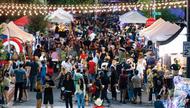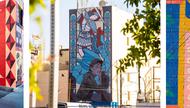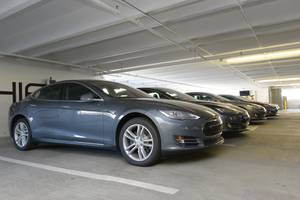Mike Janssen is director of Public Works for the City of Las Vegas. That’s his job. But recently, in the course of one of the City’s current works projects—a three-year, $109 million refresh of Las Vegas Boulevard between Sahara and Stewart avenues, which includes remakes of several nearby streets, including Casino Center and Imperial—he donned an unexpected hat. When an excavation crew working Charleston Boulevard and Gass Avenue made a strange discovery, Janssen became an archaeologist.
Downtown Rising
“When we do a project, the Water District and [Southwest Gas] say, ‘Hey, here’s an opportunity for us to put in new lines, and the city will take care of the paving.’ It’s a win-win for all of us,” Janssen says. The Gass and Charleston crew found a line that wasn’t on their map of existing utilities, which doesn’t surprise Janssen: “Downtown has some really old streets, where we don’t have good records.”
The crew gingerly dug out the unknown utility by hand. It was an abandoned water line made from—of all things—California redwood. “We got into the Water District archives: This water line was installed all over Downtown in 1908. It was abandoned in 1956, after they put in cast-iron water mains. And here we are now, removing all the cast-iron and replacing it with a sort of polyethylene plastic line.”
While that 112-year-old water line is the oldest thing Janssen has found buried beneath Downtown’s streets so far, it’s not the only antique. The water lines along Downtown’s stretch of Las Vegas Boulevard are 65 years old. Its traffic signals were installed beginning in 1965; the most recent was added in 1990. And the sewer, a piece of infrastructure you really don’t want to outlast its usefulness, was built in 1942. “We’re completely replacing it, upsizing it,” Janssen says. “I can’t imagine that my predecessor, way back in the 1940s, ever thought we’d become the 25th-largest city in the country.”
All of that, plus smart traffic signals that can communicate with vehicles, dedicated right-turn lanes and a welcome full pavement replacement, will equip Las Vegas Boulevard to deal with Downtown’s increasing traffic. But the good news isn’t exclusive to drivers.
“We’re also adding lot of what we call ‘complete street’ elements,” Janssen says. “In the old days we would do a roadwork project, and it was just for the cars. We took care of the vehicles, but in the last couple of years, we’ve taken on the perspective of all the road users.”
Accordingly, the plans for Las Vegas Boulevard and many of its intersecting streets call for new streetlights, dedicated bike lanes and sidewalks 10 to 15 feet wide, lined with shade trees. “We’re getting large trees, 48-inch, 60-inch box trees; when you plant them, they immediately provide that street canopy,” Janssen says. “Nobody has time to wait for shade.”
If you want to get an idea of what that will feel like, just head down to the Fremont East district, where work continues, or to the recently completed stretch of Third Street that runs from Charleston to Garces. Newly planted trees provide a solid blanket of shade. (The trade-off is that they partially obscure some scenic façades, in particular that of the El Cortez; hopefully that won’t be an issue after a few years of growth.) And the sidewalks are enormous, ready for street-side drinking and dining. The revamped Third Street even twists and turns a bit, adding much-needed variety to Downtown walks and bike rides. The streets simply feel better, both on foot and from behind the wheel.
The placemaking aspect of this roadwork—giving Downtown a markedly different look than the South Strip or Water Street—perhaps has no more visible expression than the two projects being constructed at Las Vegas Boulevard and Sahara. The first, an 80-foot, roadway straddling Downtown gateway arch located adjacent to the Strat, is nearly complete; you can drive under it now. It’s an impressive structure, one with a deep old-Vegas connection: It bears more than a passing resemblance to the LAX Theme Building, which was designed in part by architect Paul Revere Williams—designer of the shell-like lobby of the former La Concha Motel, now functioning as the visitor’s center for the Neon Museum.
But the other project, which is several years out, will be the true Downtown border for northbound Strip drivers: an oval-shaped pedestrian bridge connecting all four corners of Sahara and Las Vegas Boulevard in one elegant loop. At least two different support concepts for the bridge—a four-pillar suspension model, and another tall arch—are being considered, but the consistent idea is to make the bridge eye-catching and efficient. That’s the throughline of all of the City’s current Downtown road projects.
“It wouldn’t be possible if it wasn’t for the voters,” Janssen says, in reference to Las Vegas’ overwhelming support of a fuel tax index that supports Valley road project like these. “I have to thank our voters who have said, ‘We want good roads. We don’t want roads with potholes. We want roads with good lighting, roads with traffic signals where they’re needed.’ We’re able to do all that, because our community has embraced investing in transportation.”





